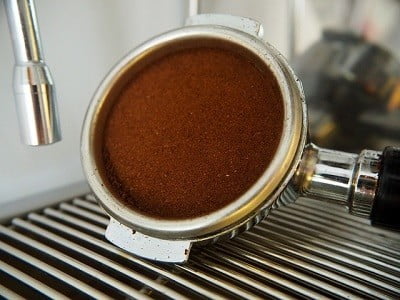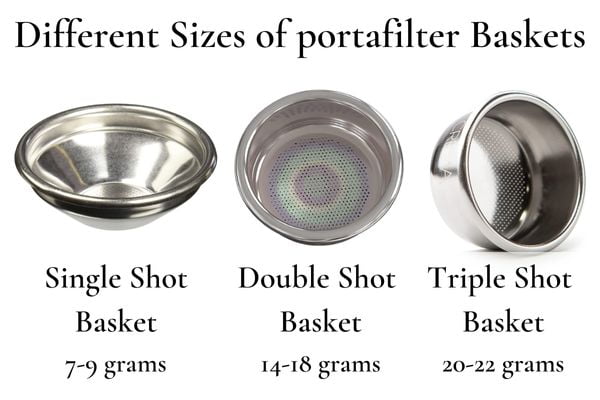There could be many reasons for a watery shot of Espresso. The quality of beans and roast might not be proper, maybe you are using the wrong grind size, the water temperature might not be correct, perhaps you are not using the right amount of coffee, or maybe you are not tamping coffee grounds correctly.
Espresso is supposed to be rich and thick with a wonderful layer of crema over it, not a weak, and dull drink without any complex flavors
There must be something wrong with your brewing technique if you always get weak, or watery espresso with a bitter aftertaste.
Key Takeaways
- Always use Freshly Roasted Coffee beans ground just before brewing.
- Use the right amount of grounds – Around 7-9 g for a single shot, 14-18g for a double. And make sure your portafilter basket fits the dose.
- Aim for an extraction time of 25-30 seconds.
- Medium or dark roasts are better for making rich and creamy Espresso.
In this post, I will discuss all the reasons in detail, and if you read the whole post, I guarantee that you will never have to drink a watery Espresso shot again in your life.

How to fix Watery Espresso?
If you are ending up with a watery espresso shot you must be doing something wrong as espresso is supposed to be intense and full-bodied. Here are some tips to fix watery espresso and make it rich and thick.
1. Use Quality of coffee beans
If you want a rich and creamy Espresso, then you must know that the quality of Beans matters a lot.
Some people prefer to have 100% Arabica Beans, while some prefer a blend of Arabica and Robusta. It entirely depends on your taste.
Authentic Italian Espresso is made with a blend of Arabica and Robusta though!

Always buy coffee beans that you can easily finish in two to four weeks. Never store coffee beans for too long as they lose their freshness as they get old.
You can use pre-ground coffee beans to pull a shot of espresso, but they can quickly lose their freshness and produce a shot with little to no crema.
For the best results, buy whole-bean coffee and grind them just before brewing.
I have tasted different Espresso beans and prepared a list of the best Espresso beans.
There is an ultimate rule for coffee aficionados, grind the beans within fifteen days of roasting and brew within fifteen minutes after grinding.
2. Grind Properly
The best grind size for pulling a perfect shot of Espresso is fine or ultra-fine.
If you use coarse grounds to pull an Espresso shot, the water will pass through the grounds too quickly, and most coffee grounds will remain under-extracted. So, you will end up with a very weak shot of espresso.

Choosing a perfect grind size for Espresso might not be easy as it involves a lot of practice.
You can play around with the grind settings in the fine or ultra-fine region of your grinder to find a perfect grind size. And select the one that results in the best cup of Espresso.
Always remember! For pulling a perfect shot of Espresso, the right time is 25-30 seconds.
If you are getting a shot of Espresso in less than 25 seconds, then the coffee grounds will remain under-extracted. In that case, you have to make the grind size finer.
For Making a better shot of Espresso read a guide on Dialing in Espresso
3. Use the Right amount of coffee Grounds
If Espresso comes out to be too watery or thin, you might not be using the right amount of coffee grounds.
The right amount of coffee grounds for a single shot espresso is around 7-9 grams while for a double shot is around 14-18 grams.

In my experience, 16 grams of coffee grounds is perfect for pulling a stronger and thicker double shot of Espresso.
4. Use the right temperature
Not all Espresso machines will allow you to play with the temperature of the water. Most Espresso machines automatically heat the water in the range of 190 to 210 degrees.
The heavy barista-style Espresso machine has a PID controller and allows you to play with water temperature.
So what’s the best temperature for Espresso?
According to the National Coffee Association: Generally, the temperature of water in the range of 195 to 205 degrees is considered optimal for pulling a shot.
For light or medium roasts aim for a temperature above 200 degrees and for darker roasts temperature of around 190 degrees is ideal.
5. Use Medium or Dark Roasts
Medium, Medium-dark, or dark roasted coffee beans are generally preferred for Espresso.
If you are using lightly roasted coffee beans for pulling a shot of Espresso, then that might be the reason your coffee comes out to be watery or thin.
Light roasts are less oily and are not ideal for Espresso brewing because they extract flavors slowly and produce weaker espresso with a thin layer of crema.
While dark roasted coffee beans are more oily, extract flavors very quickly and result in a thicker and more intense shot of Espresso.
If you like light-roasted coffee beans grind extra fine and increase the dose of coffee grounds in the portafilter!
I usually prefer medium-roasted coffee beans by Lavazza for Espresso.
Read a Guide on Light Roast vs Dark Roast Coffee
6. Tamp the coffee grounds properly
Tamping is a very critical step in pulling a great shot of Espresso.
If you don’t tamp the coffee grounds properly, the water will make its way through the coffee grounds without extracting them properly, and your Espresso will taste watery.
And If you leave the surface uneven while tamping, the water will channel through the place with fewer coffee grounds, and the taste of Espresso you get will not be consistent.

Make sure that the tamper is clean and dry before tamping. Apply enough pressure while tamping evenly in all directions, and then pull out the tamper gently. Don’t go too hard with the tamper apply just enough pressure until the puck pushes back at you.
Read a guide on How to tamp Espresso Properly
7. Change your Portafilter Basket
If you are doing all the things right and still ending up with a watery or weak shot then your portafilter basket may not be appropriate.
The screens of your portafilter basket might be clogged with old coffee grounds; In that case, clean the portafilter properly.

Another possibility is that you’re dosing less coffee into the basket than it’s designed to hold.
For example, If your basket is designed to hold 18 grams of coffee then you must add 18 grams or plus or minus 3 grams at most.
If you are pulling a single shot of Espresso using a double shot basket then you will surely end up with a watery shot as water runs through it quickly without extracting the flavors.
Here’s a detailed guide on Espresso portafilters.
Final Thoughts
A watery or weak-tasting shot of Espresso in the morning is enough to ruin your mood for the whole day.
In this article, I have discussed 7 main reasons that could result in a watery Espresso shot and how you can fix them to get a rich and creamy shot of Espresso.
You should look after these mistakes properly and always remember the main thing while pulling Espresso; It should take 25-30 seconds.
If you have applied all the solutions above and still getting a watery shot than I am afraid there might be some problem with your Espresso machine.
I would love to hear your thoughts in the comments!
Also Check out: Why is my Espresso foamy
FAQs
What does it mean if the espresso puck is watery?
A watery puck of coffee grounds after pulling a shot of Espresso can or can not be an indication of uneven extraction of coffee grounds.
It’s not a very serious problem as long as you are satisfied with the taste of the Espresso you get.
If you want to get rid of the watery puck, you must be very careful about these two things.
The size of the coffee grounds must be even and consistent, and you must tamp the coffee properly in the portafilter.
Read a detailed guide on wet Espresso Puck
Why do People drink Water with Espresso?
Many espresso drinkers enjoy pairing their shots with a small glass of water. The water cleanses the palate so they can fully enjoy and appreciate the complex flavors and aromas of espresso.



